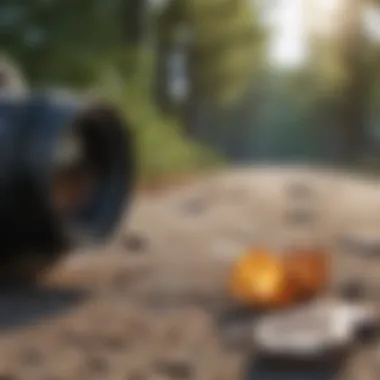Best Practices for Safe Disposal of Sharps Needles to Prevent Risks


Overview of the Topic
Current Status and Challenges
The current state of sharps needle disposal presents various challenges and threats that need to be addressed. Improper disposal methods can result in injuries to individuals who come into contact with discarded needles, leading to serious health risks such as infections and exposure to harmful pathogens. Moreover, inadequate disposal practices contribute to environmental pollution, affecting ecosystems and potentially harming wildlife.
Sustainable Solutions
Exploring sustainable practices and solutions for safe sharps needle disposal is essential in mitigating the challenges posed by improper disposal methods. Implementing designated sharps disposal containers in healthcare facilities and community settings can help reduce the risks associated with sharps needle disposal. Additionally, raising awareness about the importance of safe disposal practices and providing education on proper disposal techniques can contribute to improving waste management and reducing potential hazards.
Impact and Importance
The impact of safe sharps needle disposal extends beyond individual safety to encompass broader implications for ecosystems, communities, and future generations. By prioritizing safe disposal practices, we can minimize the risks posed by used needles and contribute to the overall well-being of both the environment and society. Emphasizing the importance of proper sharps disposal is essential in fostering a culture of responsibility and sustainability, ensuring a safer and cleaner environment for all.
Introduction
Understanding Sharps Waste
Definition of Sharps
The term 'sharps' refers to medical items that can puncture or lacerate the skin. This includes needles, syringes, lancets, and other devices used in healthcare settings. Understanding the definition of sharps is fundamental to grasp the importance of their safe disposal. The key characteristic of sharps waste lies in its potential to cause severe injuries and transmit infections. While indispensable in medical procedures, sharps pose a significant risk if not handled and disposed of properly.
Types of Sharps Waste
Sharps waste can be categorized into two main types: contaminated and non-contaminated. Contaminated sharps have come into contact with potentially infectious materials, while non-contaminated sharps have not been exposed to hazardous substances. Distinguishing between these types is critical in determining the appropriate disposal methods. The unique feature of types of sharps waste lies in their divergent risks; contaminated sharps carry the threat of transmitting diseases like HIV and hepatitis, emphasizing the need for meticulous handling.
Health Risks Associated
The health risks associated with improper sharps disposal are profound. From needle-stick injuries to bloodborne pathogen exposure, healthcare workers and the public are vulnerable to various dangers. Sharps-related injuries can result in infections, transmission of diseases, and long-term health consequences. Recognizing these risks underscores the urgency of ensuring safe and secure disposal practices. The advantage of understanding these health risks is the ability to implement stringent protocols that protect individuals and the community.
Significance of Proper Disposal
Impact on Public Health
The impact of sharps disposal on public health cannot be overstated. Inadequate disposal methods can lead to injuries, infections, and the spread of diseases among healthcare workers and the general population. Prioritizing proper disposal not only safeguards individuals but also contributes to overall public health by preventing medical waste-related illnesses.


Environmental Concerns
Environmental concerns surrounding sharps waste revolve around contamination of ecosystems and potential harm to wildlife. Improperly disposed sharps can pollute water bodies, endanger wildlife, and disrupt ecological balance. Addressing these concerns involves adopting eco-friendly disposal practices that minimize environmental impact while ensuring public safety. The essence of environmental concerns lies in preserving natural habitats and preventing pollution.
Legal Implications
The legal implications of sharps needle disposal are governed by regulations that mandate safe practices to protect public health and the environment. Non-compliance with these regulations can result in penalties, lawsuits, and reputational damage. Understanding the legal framework is vital for healthcare facilities and individuals to avoid legal entanglements and uphold ethical standards. The advantage of acknowledging legal implications is the promotion of responsible waste management practices in accordance with statutory requirements.
Regulatory Guidelines
Regulatory guidelines play a pivotal role in ensuring the safe disposal of sharps needles. These guidelines are essential for setting standard practices and protocols to prevent injuries and minimize environmental impact. Compliance with regulatory guidelines not only enhances overall public health but also addresses legal obligations. Understanding and adhering to these guidelines is crucial for individuals and healthcare facilities to create a secure disposal environment.
OSHA Regulations
Occupational Safety and Health Administration Standards
Occupational Safety and Health Administration Standards are integral in regulating and promoting workplace safety. These standards specify the necessary precautions and procedures to minimize occupational hazards, including sharps injuries. By implementing OSHA standards, organizations can foster a culture of safety and reduce the risk of needlestick incidents. The focus on continuous improvement aligns with the overarching goal of enhancing worker protection and well-being within the healthcare sector.
Compliance Requirements
Compliance requirements under OSHA regulations serve as a framework for entities to uphold safety standards effectively. These requirements outline the mandatory steps and protocols that organizations must follow to ensure full compliance with OSHA standards. By adhering to these compliance guidelines, healthcare facilities can streamline their practices, mitigate legal risks, and maintain a safe working environment. Despite some challenges in implementation, meeting compliance requirements remains instrumental in safeguarding both employees and patients.
EPA Guidelines
Environmental Protection Agency Recommendations
Environmental Protection Agency Recommendations are designed to address the ecological aspects of sharps disposal. These guidelines aim to minimize the environmental impact of medical waste, including proper handling and disposal practices. By incorporating EPA recommendations, facilities can adopt sustainable strategies that reduce pollution and promote eco-friendly initiatives. The emphasis on environmental stewardship underscores the importance of aligning sharps disposal methods with broader sustainability objectives.
Facility Obligations
Facility obligations prescribed by the EPA underscore the responsibilities that healthcare facilities bear in managing sharps waste. These obligations encompass the proper labeling, storage, and transportation of medical sharps to ensure adherence to environmental standards. By fulfilling facility obligations, organizations demonstrate their commitment to environmental conservation and regulatory compliance. Incorporating these obligations into daily practices reflects a proactive approach toward environmental sustainability and waste management efficiency.
Safe Disposal Methods
In this stringent exploration of safe sharps needle disposal, the paramount emphasis lies on the meticulous management of sharps waste, underlining the critical necessity of practicing optimal disposal methods. Establishing a robust framework for safe disposal methods is central to averting inadvertent injuries and environmental contamination. By delving into the nuances of proper disposal techniques, individuals and healthcare facilities can fortify their defenses against the potential perils associated with inadequate sharps disposal, fostering a safer and more sustainable healthcare landscape.


Home Settings
Secure Containers
An integral component of safe sharps disposal within home settings, secure containers serve as stalwart guardians of health and environmental well-being. These specially designed receptacles boast features like puncture resistance and tamper-proof lids, ensuring the secure containment of used sharps. The impermeable nature of secure containers mitigates the risk of needlestick injuries while safeguarding against hazardous exposures, rendering them an indispensable choice for this discourse. The durability and leak-proof attributes of secure containers endorse their reliability in facilitating safe disposal practices within domestic environments, aiding in the seamless containment and management of sharps waste.
Disposal Steps
Delving into the procedural intricacies of sharps disposal within home settings unveils the pivotal role of structured disposal steps. From encapsulating used needles in designated containers to sealing and labeling them appropriately, each disposal step contributes to the overarching goal of harm reduction. The systematic execution of disposal steps not only precludes accidental needle pricks but also ensures adherence to regulatory directives, promoting a culture of conscientious sharps disposal practices within the confines of one's residence. Acknowledging the significance of meticulous disposal steps illuminates their essence as foundational pillars of safe sharps needle disposal, emphasizing the imperative role they play in fostering a secure and compliant disposal milieu.
Healthcare Facilities
Sharps Bins
Within the domain of healthcare facilities, sharps bins emerge as custodians of safe sharps disposal, epitomizing containment efficacy and user-centric design. Engineered with features like fill-level indicators and tamper-proof closures, sharps bins embody the pinnacle of safety and efficiency in sharps containment practices. The optimal capacity and ergonomic design of sharps bins cater to the distinctive needs of healthcare settings, vouchsafing for seamless disposal operations while upholding the sanctity of sharps waste management. The ease of handling and secure containment afforded by sharps bins positions them as indispensable allies in promoting safe sharps disposal practices within healthcare establishments, heralding a new era of stringent adherence to disposal protocols.
Professional Services
Augmenting the arsenal of safe sharps disposal in healthcare facilities, professional services encapsulate a spectrum of value-added solutions aimed at streamlining disposal processes and enhancing regulatory compliance. Through services like regular sharps collection and disposal, healthcare facilities can delegate the responsibility of sharps management to expert professionals, offloading the burden of disposal intricacies. The tailored solutions and personalized approach characteristic of professional services resonate with the burgeoning need for sustainable and compliant sharps disposal practices in healthcare setups, underscoring their efficacy in alleviating operational bottlenecks and fostering a culture of safety and responsibility.
Best Practices
In this section focusing on Best Practices for safe sharps needle disposal, we delve into the critical components that form the foundation of a reliable sharps waste management strategy. Best Practices serve as the guiding principles that ensure the proper handling and disposal of sharps waste, mitigating risks and promoting safety. By implementing Best Practices, individuals and healthcare facilities can significantly minimize the threat of injuries and contamination. The emphasis lies on defining clear protocols for sharps disposal, utilizing secure containers, and following stringent disposal steps. These practices not only safeguard individuals but also contribute to maintaining public health and environmental integrity.
Education and Training
Staff Training Programs
Staff Training Programs play a crucial role in enhancing awareness and knowledge regarding safe sharps disposal practices. These programs aim to educate healthcare professionals and staff members on the importance of proper sharps waste management, infection control measures, and regulatory compliance. By participating in structured training sessions, staff members develop the necessary skills to handle sharps waste safely and efficiently. The key characteristic of Staff Training Programs is their interactive nature, enabling participants to engage actively with the material and simulation exercises. This hands-on approach enhances retention and empowers staff to confidently adhere to best practices in sharps disposal.
Community Awareness Campaigns
Community Awareness Campaigns are instrumental in disseminating information about safe sharps disposal practices to the general public. These campaigns focus on raising awareness about the risks associated with improper disposal of sharps waste and promoting responsible waste management behaviors. The key characteristic of Community Awareness Campaigns is their ability to reach a wide audience and instigate behavioral change on a community level. By emphasizing the importance of using designated sharps containers and participating in disposal programs, these campaigns foster a culture of accountability and environmental stewardship.
Single-Use Devices


Promotion of Disposable Sharps
Promotion of Disposable Sharps underscores the benefits of using single-use devices to reduce the risk of needlestick injuries and cross-contamination. By advocating for the widespread adoption of disposable sharps, healthcare facilities and individuals prioritize safety and infection control. The key characteristic of promoting disposable sharps is their convenience and hygienic advantages. Disposable sharps eliminate the need for sharps reprocessing, minimizing potential errors and streamlining sharps disposal processes. While disposable sharps may incur higher initial costs, their long-term benefits in terms of safety and efficiency make them a preferred choice for sharps waste management in this article.
Disposal Challenges
In the realm of safe sharps needle disposal, addressing disposal challenges is paramount to ensure effective waste management. It is crucial to navigate through the obstacles that impede proper disposal practices to safeguard public health and the environment. By delving into disposal challenges, we shed light on the complexities and nuances that influence the success of disposal initiatives. Understanding these challenges is fundamental in devising strategic solutions that can enhance overall disposal processes and mitigate associated risks.
Resource Constraints
Resource constraints play a pivotal role in shaping the landscape of sharps waste disposal. Within this domain, two key aspects come into focus - budgetary limitations and infrastructure issues.
Budgetary Limitations
One of the critical facets impacting safe disposal practices is budgetary constraints. Limited financial resources can hinder the implementation of robust disposal mechanisms and the acquisition of necessary equipment. Budgetary limitations often restrict the scope of disposal programs, affecting the overall efficacy of waste management initiatives. Despite its challenges, navigating budget constraints compels organizations to innovate cost-effective solutions, optimize existing resources, and prioritize essential disposal measures. While budgetary limitations pose significant challenges, they also drive entities to seek efficient and economical disposal methods, emphasizing the need for prudent allocation of resources.
Infrastructure Issues
Parallel to budgetary constraints, infrastructure issues exert a substantial influence on sharps waste disposal. Inadequate infrastructure, such as insufficient disposal facilities and transportation constraints, can impede the seamless flow of waste management operations. Infrastructure deficiencies pose logistical challenges, affecting the timely and secure disposal of sharps waste. Addressing infrastructure issues requires comprehensive planning, investment in infrastructure development, and collaboration across stakeholders to enhance the disposal infrastructure. Despite the hindrances posed by infrastructure issues, strategic initiatives aimed at improving waste management facilities can lead to streamlined disposal processes, minimizing risks and ensuring optimal waste disposal practices.
Behavioral Factors
Within the realm of safe sharps disposal, behavioral factors emerge as critical determinants of successful waste management practices. Proper disposal habits and adherence to guidelines play a pivotal role in minimizing risks associated with sharps waste. Understanding and addressing behavioral factors are essential in promoting a culture of responsibility and accountability towards safe disposal practices.
Proper Disposal Habits
Proper disposal habits encompass a range of behaviors and practices that influence the safe and effective management of sharps waste. Cultivating proper disposal habits involves educating individuals on the significance of responsible waste disposal, emphasizing the use of designated containers, and promoting adherence to disposal protocols. By instilling proper disposal habits, individuals can contribute to the prevention of injuries, infections, and environmental contamination associated with improper waste disposal. Emphasizing the importance of proper disposal habits fosters a culture of safety and responsibility, ensuring compliance with regulations and ethical waste management practices.
Conclusion
In the realm of proper sharps needle disposal practices, it becomes unequivocally essential to emphasize the conscientious adherence to established guidelines and regulations. The veracity of safely discarding sharps not only upholds public health but also safeguards our environment against potential hazards. Compliance with the stipulated norms ensures the containment of risks associated with improper sharps disposal, significantly minimizing injuries and environmental contamination. By honing in on the significance of implementing safe disposal methods, individuals and healthcare facilities can effectively mitigate the potential threats posed by sharps waste. This section delves into the crux of optimal practices, elucidating the necessity of stringent compliance, which remains paramount in fostering a culture of safety and responsibility around sharps disposal.
Summary of Key Points
Importance of Compliance
Delving deeper into the realm of importance of compliance within the context of sharps needle disposal, it becomes palpably evident that adherence to regulations plays a pivotal role in mitigating risks and fostering a safe disposal environment. The cornerstone of compliance lies in the strict adherence to guidelines set forth by regulatory bodies, ensuring consistency and effectiveness in the disposal of sharps waste. Strategic compliance not only safeguards public health but also alleviates environmental concerns, underscoring the critical role it plays in minimizing the consequences of improper disposal practices. Embracing compliance as a fundamental tenet in sharps disposal procedures enhances operational efficiency, promotes sustainability, and advocates for a safer, healthier community.
Future Considerations
Looking ahead to the horizon of sharps needle disposal practices, future considerations emerge as a crucial aspect in continuously refining and enhancing existing protocols. The evolution of disposal methods, the advancement of technology, and the ever-changing landscape of regulations necessitate a proactive approach towards sustainable and innovative solutions. Acknowledging future considerations not only allows for the anticipation of emerging challenges but also paves the way for the adoption of best practices that align with evolving needs. Embracing the ethos of continual improvement and adaptation ensures that sharps disposal remains at the forefront of public health agendas, fostering a culture of responsibility, sustainability, and environmental stewardship for generations to come.



